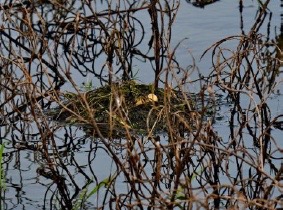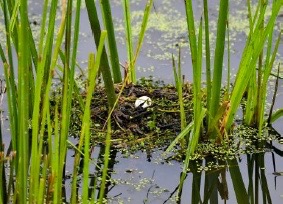Disclosure: “Where possible I used the vehicle as a hide, especially when taking video recordings. When this was not possible I ensured that my visits were brief and were a passing ‘walk-by’, during which 2-3 images were taken for documentation.
![GrebeL-nest [AmarSingh]](https://besgroup.org/wp-content/uploads/GrebeL-nest-AmarSingh.jpg)
Report
“The Little Grebe (Tachybaptus ruficollis poggei) has been recorded to colonise the northern parts of Peninsular Malaysia since the 1950s and has been noted to have spread southwards (above). It is suspected that the breeding residents are joined by migratory Grebes in the winter (Wells 1999). Unlike Little Grebes elsewhere, the resident birds in Peninsular Malaysia generally keep their ‘breeding’ plumage throughout the year.
“I observed a large number of nests in a single site, at Malim Nawar, Perak, Malaysia. This is an ex-mining pool area used for fish farming, offering a ‘wetlands’ to birds. On 20th December 2016 I observed 7 nests. When I returned on 2nd January 2017 there were 7 nests – two previous nests had been possibly destroyed by workers and a new one had been built (I presume 1 was re-built when lost recently).
“The nests are located in two ponds. One pond which houses most of the nests (7 currently) is shallow and measures 91 by 116 meters (Google Earth map). The other, where 2 nests were located (now removed), measured 200 by 210 meters and is much deeper in some sections. These nests are fragile due to their close proximity to the edge of the ponds but more so due to the presence of many foreign workers who may harvest the eggs. In addition fish farmers may view these birds as a pest. I am also concerned that excessive bird watching will put pressure on the nests, as I am seeing more persons turning up.
There are at least 12-14 adults birds at this location (see image above, showing 10 in one view). The birds respond as a group when anyone arrives and rapidly leave all nests; hence at times eggs are uncovered. Despite this I did witness some courtship behaviour with some frolicking in the water and heard many delightful calls/songs (a high pitched horse whinnying or a ‘laughing trill’); this even when I was visible to all the birds.
“A description of the 9 nests over 2 days in the table below.”
 Nest 1.
Nest 1.
Two eggs; both discoloured brown-orange. Location to “shore” is 2 metres, “shore” referring to approximate distance to edge of pond. Clear of most vegetation, few dead strands nearby. In a separate large pond, no nest nearby. One other Grebe nest in same pond.
 Nest 2.
Nest 2.
Three eggs, two discoloured brown-orange, one white. Location to “shore” is 15 metres, “shore” referring to approximate distance to edge of pond. Surrounded by dead vegetation (embedded). In a separate large pond, no nest nearby. One other Grebe nest in same pond.
 Nest 3.
Nest 3.
One egg, white. Location to “shore” is 8 metres, “shore” referring to approximate distance to edge of pond. Anchored to a reed, surrounded by dead vegetation. In a smaller pond with another six Grebe nests. Closest nest is 6-7 meters away.
.
.
 Nest 4.
Nest 4.
Number of eggs uncertain as covered. Location to “shore” is 10 metres, “shore” referring to approximate distance to edge of pond. Scattered vegetation nearby. In a smaller pond with another six Grebe nests. Closest nest is 6-7 meters away.
.
.
 Nest 5.
Nest 5.
Three eggs, all discoloured brown-orange. Location to “shore” is 2 metres, “shore” referring to approximate distance to edge of pond. Surrounded by dead vegetation (embedded). In a smaller pond with another six Grebe nests.
.
.
 Nest 6.
Nest 6.
Number of eggs uncertain as nest covered. Location to “shore” is 12 metres, “shore” referring to approximate distance to edge of pond. Surrounded by dead vegetation (embedded). In a smaller pond with another six Grebe nests.
.
.
 Nest 7.
Nest 7.
Number of eggs uncertain as nest covered. Location to “shore” is 8-10 metres, “shore” referring to approximate distance to edge of pond. Surrounded by dead vegetation on two sides. In a smaller pond with another six Grebe nests.
.
.
.
 Nest 8.
Nest 8.
One white egg. Location to “shore” is 1.5 metres, “shore” referring to approximate distance to edge of pond. Nest anchored and surrounded by reeds. In a smaller pond with another six Grebe nests.
.
.
.
.
 Nest 9.
Nest 9.
Number of eggs uncertain as nest covered. Location to “shore” is 8 metres, “shore” referring to approximate distance to edge of pond. Scattered vegetation around. In a smaller pond with another six Grebe nests.
.
.
.
Dato’ Dr Amar-Singh HSS
Ipoh, Perak, Malaysia
2nd January 2017








